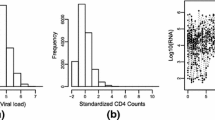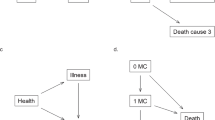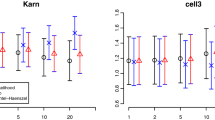Abstract
The inference in multi-state models is traditionally performed under a Markov assumption that claims that past and future of the process are independent given the present state. This assumption has an important role in the estimation of the transition probabilities. When the multi-state model is Markovian, the Aalen–Johansen estimator gives consistent estimators of the transition probabilities but this is no longer the case when the process is non-Markovian. Usually, this assumption is checked including covariates depending on the history. Since the landmark methods of the transition probabilities are free of the Markov assumption, they can also be used to introduce such tests by measuring their discrepancy to Markovian estimators. In this paper, we introduce tests for the Markov assumption and compare them with the usual approach based on the analysis of covariates depending on history through simulations. The methods are also compared with more recent and competitive approaches. Three real data examples are included for illustration of the proposed methods.











Similar content being viewed by others
References
Aalen O, Johansen S (1978) An empirical transition matrix for non homogeneous Markov and chains based on censored observations. Scand J Stat 5:141–150
Allignol A, Beyersmann J, Gerds T, Latouche A (2014) A competing risks approach for nonparametric estimation of transition probabilities in a non-Markov illness-death model. Lifetime Data Anal 20:495–513
Andersen PK, Keiding N (2002) Multi-state models for event history analysis. Stat Methods Med Res 11:91–115
Andersen PK, Borgan O, Gill RD, Keiding N (1993) Statistical models based on counting processes. Springer, New York
Andersen PK, Esbjerg S, Sorensen TIA (2000) Multistate models for bleeding episodes and mortality in liver cirrhosis. Stat Med 19:587–599
Beyersmann J, Schumacher M, Allignol A (2012) Competing risks and multistate models with R. Springer, New York
Borgan O (2005) Encyclopedia of biostatistics: Aalen–Johansen estimator. Wiley, New York
Chiou SH, Qian J, Mormino E, Betensky RA (2018) Permutation tests for general dependent truncation. Comput Stat Data Anal 128:308–324
Cox DR (1972) Regression models and life tables (with discussion). J R Stat Soc Ser B 34:187–200
Datta S, Satten GA (2001) Validity of the Aalen–Johansen estimators of stage occupation probabilities and Nelson–Aalen estimators of integrated transition hazards for non-Markov models. Stat Probab Lett 55:403–411
de Uña-Álvarez J, Meira-Machado L (2015) Nonparametric estimation of transition probabilities in the non-Markov illness-death model: a comparative study. Biometrics 71:364–375
Genser B, Wernecke KD (2005) Joint modelling of repeated transitions in follow-up data—a case study on breast cancer data. Biom J 47(3):388–401
Hougaard P (2000) Analysis of multivariate survival data. Springer, New York
Kay R (1986) A Markov model for analyzing cancer markers and disease states in survival studies. Biometrics 42:457–481
Meira-Machado L (2016) Smoothed landmark estimators of the transition probabilities. SORT-Stat Oper Res Trans 40:375–398
Meira-Machado L, Sestelo M (2019) Estimation in the progressive illness-death model: a nonexhaustive review. Biom J 61(2):245–263
Meira-Machado L, de Uña-Álvarez J, Cadarso-Suárez C (2006) Nonparametric estimation of transition probabilities in a non-Markov illness-death model. Lifetime Data Anal 12:325–344
Meira-Machado L, de Uña-Álvarez J, Cadarso-Suárez C, Andersen PK (2009) Multi-state models for the analysis of time-to-event data. Stat Methods Med Res 18:195–222
Moertel CG, Fleming TR, Macdonald JS, Haller DG, Laurie JA, Tangen CM, Ungerleider JS, Emerson WA, Tormey DC, Glick JH, Veeder MH, Mailliard JA (1995) Fluorouracil plus levamisole as effective adjuvant therapy after resection of stage III colon carcinoma: a Final Report. Ann Intern Med 122(5):321–326
Pérez-Ocón R, Ruiz-Castro JE, Gámiz-Pérez ML (2001) Non-homogeneous Markov models in the analysis of survival after breast cancer. J R Stat Soc Ser C 50(1):111–124
Putter H, Spitoni C (2018) Non-parametric estimation of transition probabilities in non-Markov multi-state models: the landmark Aalen–Johansen estimator. Stat Methods Med Res 27(7):2081–2092
Putter H, Fiocco M, Geskus RB (2007) Tutorial in biostatistics: competing risks and multi-state models. Stat Med 26:2389–2430
Rodriguez-Girondo M, de Uña-Álvarez J (2012) A nonparametric test for Markovianity in the illness-death model. Stat Med 31(30):4416–4427
Rodriguez-Girondo M, de Uña-Álvarez J (2016) Methods for testing the Markov condition in the illness-death model: a comparative study. Stat Med 35(20):3549–3562
Sauerbrei W, Royston P (1999) Building multivariable prognostic and diagnostic models: transformation of the predictors by using fractional polynomials. J R Stat Soc Ser A 161(1):71–94
Titman AC (2015) Transition probability estimates for non-Markov multi-state models. Biometrics 71:1034–1041
Titman AC, Putter H (2020) General tests of the Markov property in multi-state models. Bio-statistics. https://doi.org/10.1093/biostatistics/kxaa030
Van Houwelingen HC (2007) Dynamic prediction by landmarking in event history analysis. Scand J Stat 34(1):70–85
Acknowledgements
This research was financed by Portuguese Funds through FCT—“Fundação para a Ciência e a Tecnologia”, within the research Grants PTDC/MAT-STA/28248/2017 and PD/BD/142887/2018.
Author information
Authors and Affiliations
Corresponding author
Ethics declarations
Conflict of interest
The authors have declared no conflict of interest.
Additional information
Publisher's Note
Springer Nature remains neutral with regard to jurisdictional claims in published maps and institutional affiliations.
Rights and permissions
About this article
Cite this article
Soutinho, G., Meira-Machado, L. Methods for checking the Markov condition in multi-state survival data. Comput Stat 37, 751–780 (2022). https://doi.org/10.1007/s00180-021-01139-7
Received:
Accepted:
Published:
Issue Date:
DOI: https://doi.org/10.1007/s00180-021-01139-7




